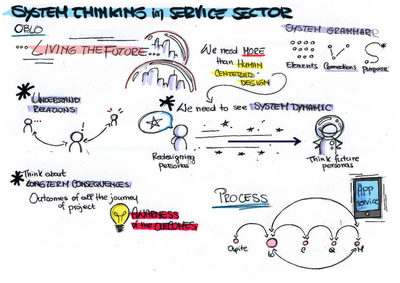Systems thinking for service design
Besplemennova, Yulia and Tassi, Roberta (2018) Systems thinking for service design. In: Proceedings of RSD7, Relating Systems Thinking and Design 7, 23-26 Oct 2018, Turin, Italy.
Preview |
Text
Besplemennova_SystemsThinking_2018.pdf Download (2MB) | Preview |
Preview |
Text
Besplemennova_Slides_2018.pdf Download (19MB) | Preview |
![Besplemennova_Tassi_MM_2018.jpg [thumbnail of Besplemennova_Tassi_MM_2018.jpg]](https://openresearch.ocadu.ca/2736/3.hassmallThumbnailVersion/Besplemennova_Tassi_MM_2018.jpg)  Preview |
Image
Besplemennova_Tassi_MM_2018.jpg Download (131kB) | Preview |
Abstract
As a discipline that deals mostly with complex, intangible components, service designers have developed a broad toolkit to visualise and interact with the elements that can be difficult to perceive otherwise.
Examining service design tools closely one can see a strong link between them and tools used in systems thinking to visualize behaviours and structures. In fact (eco)system mapping is one of the main tools for service designers, service blueprint adopts swim-lane charts to understand layering of the various channels and actors while providing a service, and user-journey can be seen as a detailed view of the system interactions and dynamics.
However despite the highly systemized nature of service design approach and tools, not all applications lead to a positive systemic impact. And as services (and especially digital services and platforms) play more and more important role in the general economy and the distribution of capital, resources and human flows, we clearly need to think on the larger scale and understand how to augment our tools to comprehend the large-scale and long-term impacts.
Approaching systems thinking from within the service design practice we would like to examine in detail some emerging needs that we should consider when thinking of tools and processes that support our practice:
the need of observing systems in dynamics to better understand their behaviour and how they can evolve over time;
the importance of understanding the interconnectedness of a given system, its subsystems and other external systems, mapping out all the relationships involved;
the need to focus on the long-term consequences of our actions and of the externalities that were not taken care off in the previous solutions, in order to achieve a more positive impact.
In our contribution we would like to show how augmented service design tools can help designers better including system thinking in their everyday practice.
From Personas to Dynamic Personas
Personas are a fictional narrative used to describe the needs, expectations and desires of specific types of users, and come up with ideas and solutions that meet those needs. Dynamic personas extend this concept by looking at how the user behaviour could evolve over time.
This means defining a target for them to reach, or multiple targets, and flash out the possible scenarios in which that persona would or wouldn’t be able to achieve those goals.
We will show how we have applied this tool in a project with Mozilla, to better understand the enabling and blocking factors affecting the way people relate to Internet Health issues.
From System Map to System Loops
System maps are synthetic representations that describe how a system is structured, by displaying all the actors and showing their connections. System loops enrich system maps by always showing the relationship among two actors as an exchange in which they are both giving and receiving something. This means analysing more in depth the dynamics that sustain the system, mapping out tangible and intangible exchanged values and immediately visualising critical issues, gaps and redundancies.
We will show how we used system loops to better understand the relationship between citizens and Public Institutions, to identify all the data, money and document exchanges and how they could be optimized.
From Roadmap to Impact Roadmap
A project roadmap is a very functional tool that allows a company or organization to define all the steps needed to bring a certain service or product to life. An impact roadmap expands the project phases and milestones with additional layers, enlightening possibilities to generate value while moving along the process, as direct or indirect consequence of the main activities and actions. This means reflecting on all the actors surrounding the development of a solution and identifying strategies to generate positive engagements.
We will show how designers can generate value along the execution of a service design process, by sharing a story from a project with American Red Cross in Kenya and South Africa.
These three examples are just the beginning of possible augmentation of service design tools for more sustainable and impactful practice. We started to apply them on our projects, tested them with other practitioners during the recent ArchitectaDay in Torino, and we hope to have the opportunity to further extend this conversation, and expand the systemic service design toolkit.
| Item Type: | Conference/Workshop Item (Paper) |
|---|---|
| Uncontrolled Keywords: | Systems thinking, Design thinking, Service design, Service design tools |
| Related URLs: | |
| Date Deposited: | 11 Jul 2019 21:47 |
| Last Modified: | 20 Dec 2021 16:09 |
| URI: | https://openresearch.ocadu.ca/id/eprint/2736 |
Actions (login required)
 |
Edit View |

 Lists
Lists Lists
Lists